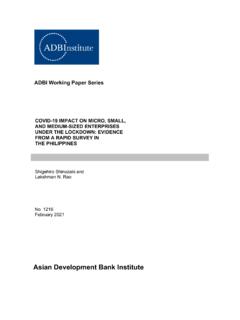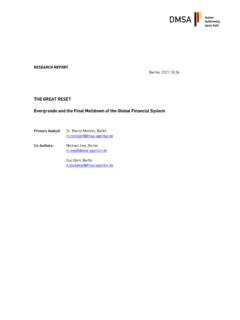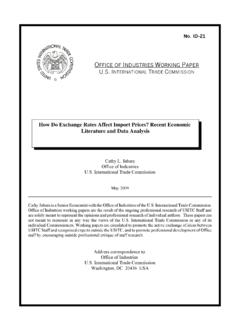Transcription of Patterns of Democracy
1 Patterns of DemocracyThis page intentionally left blank Patterns OF DEMOCRACYG overnment Forms and Performance in Thirty-Six CountriesSECOND EDITIONAREND LIJPHARTF irst edition 1999. Second edition 1999, 2012 by Arend rights book may not be reproduced, in whole or in part, including illustrations, in any form (beyond that copying permitted by Sections 107 and 108 of the US Copyright Law and except by reviewers for the public press), without written permission from the University Press books may be purchased in quantity for educational, business, or promotional use. For information, please e-mail (US offi ce) or (UK offi ce).Set in Melior type by Integrated Publishing Solutions, Grand Rapids, in the United States of of Congress Cataloging-in-Publication DataLijphart, Arend. Patterns of Democracy : government forms and performance in thirty-six countries / Arend Lijphart. 2nd ed. p. cm. Includes bibliographical references and 978-0-300-17202-7 (paperbound : alk.)
2 Paper) 1. Democracy . 2. Comparative government. I. 2012 dc23 2012000704A catalogue record for this book is available from the British paper meets the requirements of ANSI/NISO 1992 (Permanence of Paper).10 9 8 7 6 5 4 3 2 1for Giselaand for our grandchildren, Connor, Aidan, Arel, Caio, Senta, and Dorian,in the hope that the twenty-fi rst century their century will yet become more democratic, more peaceful, kinder, and gentler than the one our generation has bequeathed to themThis page intentionally left blank Contents Preface t o the Second Edition ix Preface to the First Edition xv 1: Introduction 1 2: The Westminster Model of Democracy 9 3: The Consensus Model of Democracy 30 4: Thirty-Six Democracies 46 5: Party Systems: Two-Party and Multiparty Patterns 60 6: Cabinets: Concentration Versus Sharing of Executive Power 79 7:Executive-Legislative Relations: Patterns of Dominance and Balance of Power 105 8:Electoral Systems: Majority and Plurality Methods Versus Proportional Representation 130 9: Interest Groups: Pluralism Versus Corporatism 15810.
3 Division of Power: The Federal-Unitary and Centralized-Decentralized Contrasts 174viii CONTENTS11:Parliaments and Congresses: Concentration Versus Division of Legislative Power 18712:Constitutions: Amendment Procedures and Judicial Review 20413:Central Banks: Independence Versus Dependence 22614:The Two-Dimensional Conceptual Map of Democracy 23915:Effective Government and Policy-Making: Does Consensus Democracy Make a Difference? 25516:The Quality of Democracy and a Kinder, Gentler Democracy : Consensus Democracy Makes a Difference 27417:Conclusions and Recommendations 295 Appendix: Two Dimensions and Ten Basic Variables, 1945 2010 and 1981 2010 304 References 311 Index 338 Preface to the Second EditionI welcome the opportunity to publish an updated edition of Pat-terns of Democracy , originally published in 1999, because it givesme an opportunity to test whether my main fi ndings and conclu-sions continue to be valid especially my fi nding that the great variety of formal and informal rules and institutions that we fi nd in democracies can be reduced to a clear two-dimensionalpatternon the basis of the contrast between majoritarian and consensus forms of government, and my conclusion that consensus democ-racies (measured on the fi rst of these dimensions) have a superior record with regard to effective policy-makingand the quality of Democracy compared with majoritarian democracies.
4 The basic organization of the book has not changed, but the data on which its empirical analysis is based has changed in important ways. First, my analysis continues to compare the same number of democracies thirty-six but three of the countries had to be re-moved because they are no longer free and democratic according to the criteria of Freedom House: Colombia, Venezuela, and Papua New Guinea. I replaced them with Argentina, Uruguay, and Korea, which returned to Democracy in the 1980s. Second, I extended the analysis from 1996 to 2010, which en-ixx PREFACE TO THE SECOND EDITION tails a considerable increase in the time span during which the other thirty-three democracies are analyzed: a 74 percent in-crease for the newest democracies included in the fi rst edition India and Spain smaller but still substantial increases for the countries that became democratic between the 1950s and the early 1970s, and even a signifi cant 28 percent increase for the older democracies analyzed from the late 1940s on.
5 Third, I made no major changes in the defi nition and measure-ment of the ten basic variables that make up the majoritarian-consensus contrast, with two important exceptions. In hindsight, I concluded that the way I operationalized executive dominance in Chapter 7 of the original edition was too complicated and cumbersome; I therefore use a much simpler and more straight-forward operationalization in the updated edition. In Chapter 13, I was forced to change the treatment of central bank indepen-dence because from the mid -1990s on the internationalization of central banking in particular, the creation of the European Cen-tral Bank and changes in several national central bank charters demanded by the International Monetary Fund changed the sta-tus of central banks from domestic institutions to organizations in the international system. A less important change is that I reduced my discussion of the issue dimensions of partisan confl ict whichis not an institutional variable and is not one of the basic ten variables distinguishing majoritarian from consensus Democracy from about a third of Chapter 5 to a more appropriately short ad-dendum to that chapter.
6 Fourth, the biggest changes are in Chapters 15 and 16 with regard to the variables by which I measure the performance of consensus versus majoritarian democracies. Some of these variables like economic growth, the control of infl ation and unemployment, women s representation, and political equality are the same as in the original edition, but the data on them are for later periods and therefore almost completely new. A few others, like social expenditure and environmental performance, are also the same but measured by new and different indexes. And then there are PREFACE TO THE SECOND EDITION xientirely new variables not used in the original edition at all. I also streamlined the presentation of the results of the regression analyses. Instead of showing the bivariate relationships between consensus Democracy and the performance variables in the ta-bles and discussing the infl uence of control varia bles, especially the impact of the level of economic development and popu-lation size, in the accompanying text, I now have tables show-ing multivariate regression analyses of the effects of consen-sus Democracy with these two standard controls in place in all instances.
7 Generally the quality of all the new data is a great deal better than the quality of the data that I had at my disposal in the mid -1990s, and they are available for many more countries. In par-ticular, I made grateful use of two entirely new and highly rele-vant datasets for the measurement of the quality of government and the quality of Democracy , respectively: the Worldwide Gov-ernance Indicators and the data of the Democracy Index project of the Economist Intelligence Unit. Not only have excellent data become much more available in the past decade, but they have also become more easily accessible. In the preface to the fi rst edi-tion, I wrote that I might not have been able to write it without the invention of email. I can now add that this new edition might not have been possible, or would have been much more diffi cult to write, without all of the information that is available on the internet. To briefl y preview my conclusions in the updated edition, I fi nd that my original conclusions are amply confi rmed.
8 In fact, the evidence with regard to the interrelationships of my ten ma-joritarian versus consensus characteristics and with regard to the superior performance of consensus Democracy has become even clearer and preparation of a study of as many as thirty-six countries is impossible without the input of many comparative and country experts. I am deeply grateful to my friends and colleagues for the valuable advice and assistance I received from them. First of all, xii PREFACE TO THE SECOND EDITIONI want to express my thanks again to everyone who helped me with the fi rst edition of this book. Their input is still refl ected in the contents of this second edition, too. I was especially in need of assistance with regard to the three new countries in the updated edition, and I am grateful for the excellent advice on Korean politics from Taekyoon Kim, Kyoung-Ryung Seong, Jong-Sung You, and my Korean research assistant, Don S. Lee. For Argentina and Uruguay I had a huge team of aides and advisers, and I am deeply indebted to them all: David Alt-man, Octavio Amorim Neto, Marcelo Camerlo, Rossana Casti-glioni, Sebasti n Etchemendy, Mark P.
9 Jones, Jorge Lanzaro, An-dr s Malamud, M. Victoria Murillo, Sebasti n M. Saiegh, and Andrew Schrank. For recent developments in several other coun-tries I relied on the advice of Edward M. Dew, Fragano S. J. Ledg-ister, Ralph R. Premdas, and Rajendra Ramlogan (Barbados and the other Caribbean countries); Carl Devos and Luc Huyse (Bel-gium); Pradeep K. Chhibber and Ashutosh Varshney (India); Yuko Kasuya and Mikitaka Masuyama (Japan); Deborah Br uti-gam, J rgen Elklit, Shaheen Mozaffar, Linganaden Murday, and Nadarajen Sivaramen (Mauritius); Peter Aimer and Jack Vowles (New Zealand); Richard Gunther and scar Mart nez-Tapia (Spain); Matthew Flinders, Michael Gallagher, and Thomas C. Lundberg (United Kingdom); and Gary C. Jacobson (United States). I am equally grateful to all of the scholars who helped me in im-portant subject areas: Krista Hoekstra, Hans Keman, Jelle Koedam, and Jaap Woldendorp (cabinet coalitions); Daniel M. Brinks, Isaac Herzog, Donald W.
10 Jackson, and Mary L. Volcansek (judicial re-view); Christopher Crowe and Mauro F. Guill n (central banks); and Scott Desposato, Stephen J. K. Lee, Philip G. Roeder, and Se-basti n M. Saiegh (statistical and computer issues). Other scholars whom I would like to thank without placing them in country or subject categories are Ernesto Alvarez, Jr., Julian Bernauer, Joseph H. Brooks, Royce Carroll, Josep M. Colomer, Zachary Elkins, John Gerring, Ronald F. Inglehart, Mona Lena Krook, Sanford A. Lak-off, Dieter Nohlen, Matt H. Qvortrup, Manfred G. Schmidt, Alan PREFACE TO THE SECOND EDITION xiiiSiaroff, Fabia Soehngen, Rein Taagepera, Steven L. Taylor, and Adrian Vatter. In April 2011, I gave seminars on the fi ndings of this updated edition at the Juan March Institute in Madrid and at the Madrid campus of Suffolk University, and in November 2011 a similar seminar in the Department of Politics of the University of Ant-werp. The comments and questions I received from the partici-pants in these seminars were very helpful.











